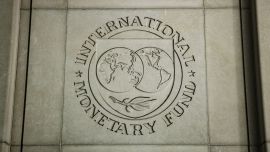Interest rates on Argentine peso notes are soaring across the board, piling pressure on banks amid a liquidity crunch caused by government efforts to defend the local currency.
The one-day peso repo rate surged on average to 65 percent on Tuesday – the highest since May 2024 – after briefly touching triple digits during the final hour of intraday trading last Friday. At the same time, the yield on short-term Treasury notes known as Lecaps reached 59.5 percent, its highest level since October 2024, when inflation was running at 193 percent, almost five times the current rate.
“The Treasury left very few pesos in the market, and several banks – especially smaller ones – ran out of liquidity and had to scramble for cash, offering higher rates on interest-bearing accounts, selling Lecaps, or borrowing via repos and bank calls at steep rates,” said Emiliano Merenda, chief executive officer of local broker Pharos Capital.
The Central Bank has tightened monetary policy and the government has introduced mechanisms to absorb pesos to stabilise the currency amid a seasonal decline in exports and investor concerns over congressional elections in October. The country’s monetary authorities have been selling Lecaps and raising reserve requirements for money market funds. While the strategy may attract carry trade flows, it has drained liquidity – forcing many banks to turn to the repo market at sky-high rates.
“Liquidity dried up and right now there’s no lender of last resort,” said Belisario Álvarez de Toledo, head trader and partner at True Grit Capital in Buenos Aires. “No-one is stepping in to provide liquidity.”
The National Bank Association and the Central Bank declined to comment, while the Foreign Bank Association didn’t immediately respond to questions.
The measures have brought some respite for the peso, which is trading at about 1,273 to the dollar on Tuesday, strengthening from an intraday low of 1,293 on Monday.
The peso squeeze has been worsened by month-end dynamics, when banks must meet reserve requirements and have less flexibility in managing short-term cash.
“This is going to affect banks’ solvency, especially the smaller ones, because funding costs have soared,” Merenda said. Just two weeks ago, they were borrowing below 30 percent. Now they’ve had to pay 55 percent.
Some analysts also warned that tight monetary policy will make it harder for the central bank to boost foreign currency reserves in line with its International Monetary Fund agreement. To avoid printing pesos, the government has been reluctant to buy dollars, missing its end-June reserve target and requiring a waiver from the IMF. Now, with the exchange rate under pressure and local liquidity tight, the Treasury is buying dollars – but at a relatively high exchange rate as the peso has depreciated in recent months.
In response, many investors are steering clear of peso assets altogether. Even with high returns, the volatility and policy uncertainty are leading funds and savers to borrow pesos instead – using them to dollarise portfolios rather than hold on to local instruments. It’s a sign of falling demand for local currency that outweighs the government’s efforts to restrict money supply, and signals a rough road ahead for Argentina’s financial system in a high-stakes election season.
The spike in funding costs can’t last much longer without seriously threatening banks’ solvency, said Álvarez de Toledo.
“Argentine banks rely heavily on very short-term funding, so a sharp rise in short-term interest rates puts their profit margins under severe pressure,” he said. “This needs to be resolved – the system simply can’t function without liquidity.”
related news
by Ignacio Olivera Doll, Bloomberg























Comments